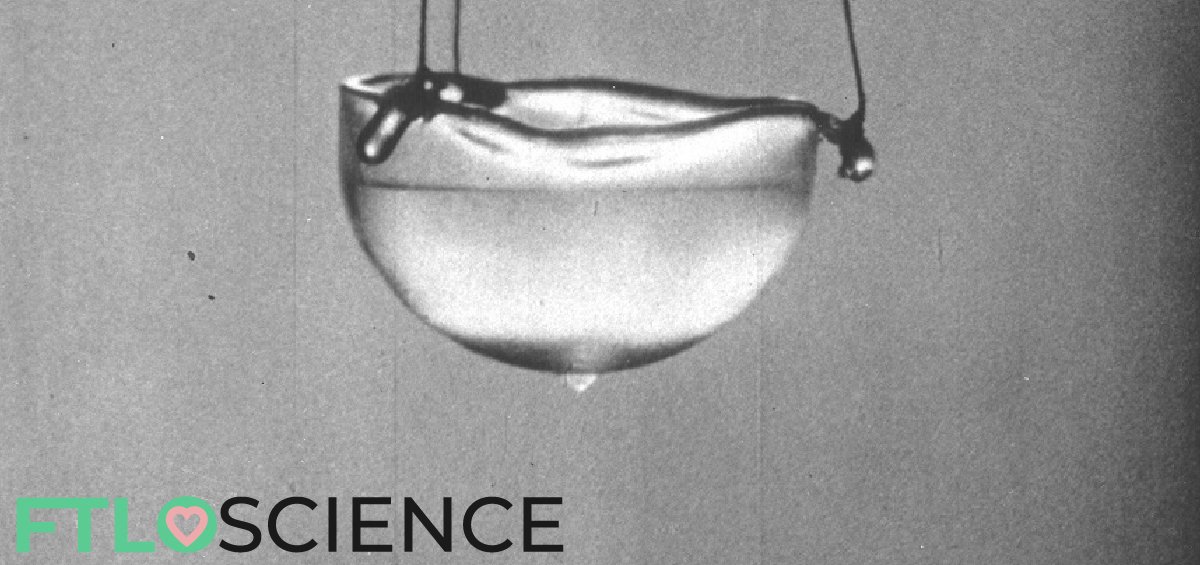The ability of helium in its liquid state to seemingly disobey the laws of physics has been the subject of study for almost a century; what occurs is a spontaneous process in which liquid helium rises up and out of its container. Yet this phenomenon is not commonly taught in schools, or even universities for that matter. In this article, we will attempt to explain the science behind this phenomenon in the simplest terms possible.
Liquid Helium
tl;dr: As a container of liquid helium is cooled past its λ point, a fraction of its particles ‘condense’ and exist in their lowest energy state. This superfluid phase possesses an extremely high heat capacity and conductivity due to its unique mechanism of heat transfer as a flow of entropy. This was shown to form a film that creeps out of the sides of a container owing to a thermodynamically reversible process. The rate of transfer is dependent on temperature and hence in an undisturbed system, this flow equilibrates as a linear function against time.
Strange Behavior of Cooled Helium
Helium-4, the most common isotope of helium, has a boiling point of just 4.2 K under standard atmospheric pressure. The low temperatures required for helium to transition from a liquid to gas can be attributed to its weak interatomic forces due to it being a noble gas. Furthermore, its low atomic mass means that helium atoms tend to stay apart from each other as this decreases its ground state energy, a naturally occurring quantum phenomenon.
Despite this, its liquid phase has been studied extensively over the years. At temperatures just under its boiling point, liquid helium behaves like a normal liquid. It exhibits properties such as possessing viscosity, filling its container and having limited heat conduction capabilities.
In order for liquid helium to diverge from the rules of classical mechanics, it has to be further cooled past a critical point known as its lambda (λ) point (Fig. 1). Once below the λ point, liquid helium spontaneously rises up the sides and out of its containers. Very spooky.

The Critical (Lambda) Point
In order to achieve these extremely low temperatures, liquid helium is cooled using a vacuum pump. By reducing the pressure in the container, it causes evaporation and heat loss to occur so that temperatures under the λ point can be attained. It is at and below this point that helium can be described in its superfluid form, helium II.
The λ point of helium-4 is around 2.2K4, below which it begins to exhibit such behaviors which were found to be closely linked to that of an ideal Bose-Einstein gas3. However, due to the fact that this phenomenon was originally applied to gases whereas helium-4 is in its liquid phase, some of these statistics had to be altered to accommodate the presence of intermolecular forces.
Thus a model would need to be constructed in which helium II could be described under the conditions of an ideal Bose-Einstein gas. That is, a fraction of particles distributed over excited states determined by temperature, and with another fraction condensed at the lowest energy level5.
The Two-Fluid Model
Two ‘States’ in Helium II
This led to the two-fluid model of helium II being described3, with atoms not strictly belonging in either ground or excited state but rather possessing two kinds of flow4. In a two-fluid model, when placed in a rotating vessel, only the ‘normal’ phase is carried along with the vessel while the ‘superfluid’ phase is stationary. In reality, however, this mixture cannot actually be divided and the model is simply used to describe the phenomena of atoms possessing two simultaneously possible quantum motions6.
The behavior of helium II as a result of possessing a high heat capacity (Fig. 1) near the lambda point can now be investigated. It is assumed that a cooperative process is involved in the heat conduction of helium II. That is, at the λ point almost all of its thermal energy is present as the energy of disordered states7. Hence the flow of heat within the liquid helium lattice8 is described as a flow of disorder rather than the flow of vibrational energy in a classical solid.
Explaining the Rollin Film Phenomenon
The ability to rise up the sides of its container is limited to the superfluid phase of helium II. A film forms on surfaces that helium II is in contact with9 and moves out of the sides of its container, always collecting on the lowest level possible. The Rollin film gets its name from Bernard Vincent Rollin, a physicist, and not because it rolls out of the container it finds itself in.
This phenomenon is attributed to a large heat transfer between the ‘hot’ normal fraction and ‘cold’ superfluid fraction. However, superfluid helium does not carry heat in the classical sense. As it lacks other sources of energy dissipation, its motions are thermodynamically reversible and this is evidenced by the temperature of helium flowing out of its container actually being lower than the helium inside the container10.
This system was investigated and each fraction was shown to possess different velocities as they flowed, known as the first and second sound of helium II6.

It was discovered that the rate of helium flowing out of its container followed a linear gradient (Fig. 2), which meant that the levels of helium inside and outside of the container had no effect on the velocity of transfer11. It was also found that the direction of flow of the liquid is always opposite to the flow of heat i.e. a transfer of energy is involved12; this further established that the mechanism of this ‘transfer effect’ was not related to a simple siphon.
By applying the Bose-Einstein condensation to this process, the superfluid fraction of helium II can move without facing any resistance, and therefore its transport out of the beaker would require a corresponding flow of heat5. This theory applies to the experimental data gathered (Fig 2).
As the container is removed from the bath there is a sharp increase in temperature and this is reflected by a high initial rate of transfer. As higher temperatures mean a smaller fraction of helium is superfluid, this slows down the overall transfer. However heat is also lost through evaporation and conduction which means an equilibrium is established between the normal and superfluid fractions of helium over time11, hence the linear rate of transfer out of the container.
Reference
- Wilks, J. The properties of liquid and solid helium (1967).
- Buckingham, M. J., & Fairbank, W. M. The nature of the Lambda transition. Progress in low temperature physics, 3, 138 (1961)
- London, F. On the bose-einstein condensation. Physical Review, 54(11), 947 (1938).
- Gorter, C. J., & Mellink, J. H. On the irreversible processes in liquid helium II.?Physica,?15(3-4), 285-304 (1949).
- Tisza, L. Transport phenomena in helium II. Nature, 141, 913 (1938).
- Landau, L. Theory of the Superfluidity of Helium II. Physical Review,60(4), 356 (1941).
- Allen, J. F., & Misener, A. D. Flow of liquid helium II. Nature,141(3558), 75 (1938).
- London, F. On condensed helium at absolute zero. Proceedings of the Royal Society of London. Series A, Mathematical and Physical Sciences, 153(880), 576-583 (1936).
- Rollin, B. V., & Simon, F. On the film phenomenon of liquid helium II. Physica, 6(2), 219-230 (1939).
- Kapitza, P. L. Heat transfer and superfluidity of helium II. Physical Review, 60(4), 354 (1941).
- Daunt, J. G., & Mendelssohn, K. The Transfer Effect in Liquid He II. I. The Transfer Phenomena.?Proceedings of the Royal Society of London. Series A, Mathematical and Physical Sciences, 423-439 (1939).
- Allen, J. F., & Reekie, J. Momentum transfer and heat flow in liquid helium II. In?Mathematical Proceedings of the Cambridge Philosophical Society (Vol. 35, No. 01, pp. 114-122). Cambridge University Press (1939).
- Balibar, S. Looking back at superfluid helium. In Poincaré Seminar 2003(pp. 17-29). Birkhäuser Basel (2004).
- Penrose, O., & Onsager, L. Bose-Einstein condensation and liquid helium. Physical Review, 104(3), 576 (1956).
About the Author

Sean is a consultant for clients in the pharmaceutical industry and is an associate lecturer at La Trobe University, where unfortunate undergrads are subject to his ramblings on chemistry and pharmacology.




